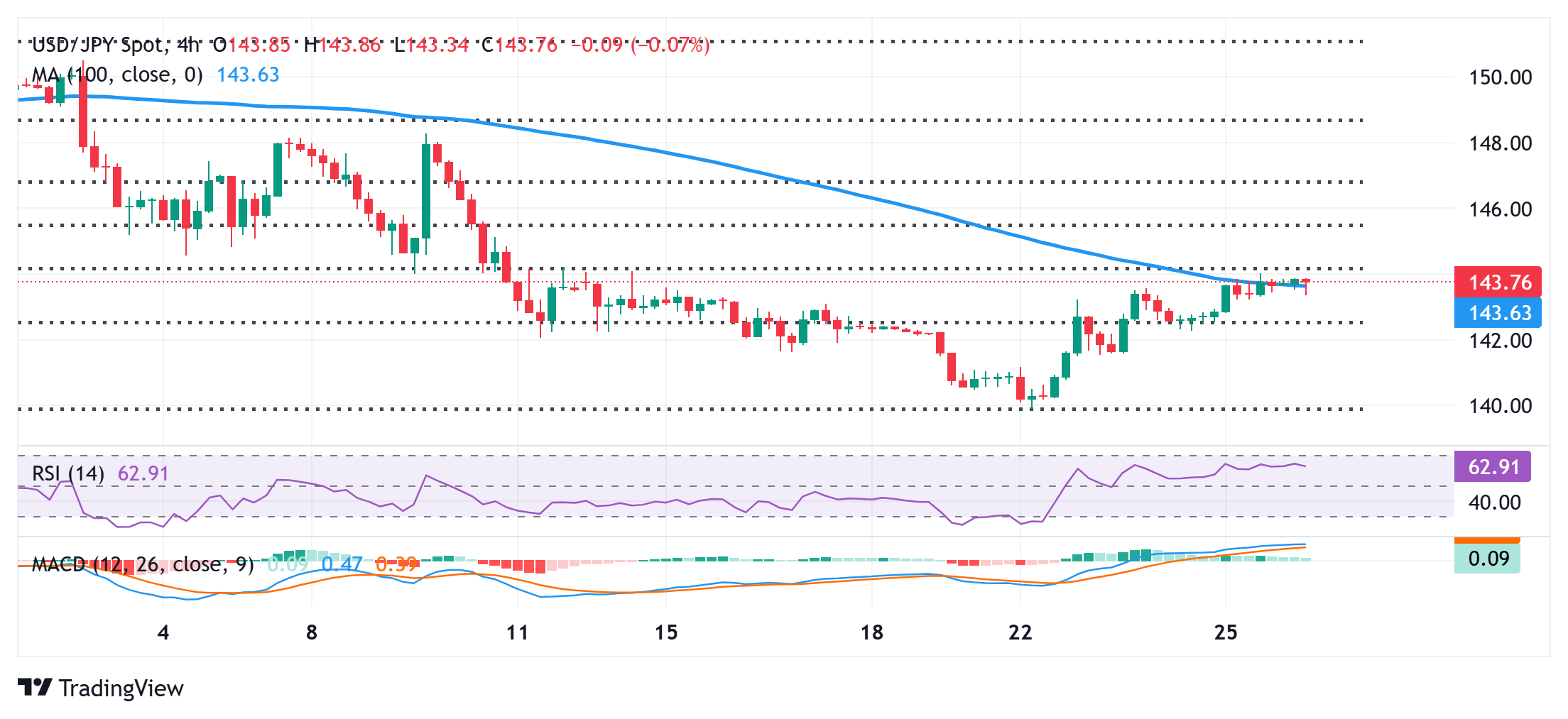Created
: 2025.04.28














![]() 2025.04.28 11:33
2025.04.28 11:33
The Japanese Yen (JPY) oscillates in a narrow range during the Asian session on Monday and stalls the recent pullback from a multi-month high touched against its American counterpart last week. US Treasury Secretary Scott Bessent did not back President Donald Trump's assertion that tariff talks with China were underway. This keeps a lid on the optimism over a quick resolution of trade tensions between the world's two largest economies and lends some support to the safe-haven JPY.
Meanwhile, traders have pushed back expectations for an immediate interest rate hike by the Bank of Japan (BoJ) due to rising economic risks from US tariffs. However, signs of broadening inflation in Japan keep the door open for more BoJ rate hikes this year, which marks a big divergence in comparison to bets for more aggressive policy easing by the Federal Reserve (Fed). This keeps the US Dollar (USD) bulls on the defensive and also acts as a tailwind for the lower-yielding JPY.

A sustained move beyond the 100-period Simple Moving Average (SMA) on the 4-hour chart will be seen as a key trigger for the USD/JPY bulls against the backdrop of last week's breakout above the 23.6% Fibonacci retracement level of the March-April downfall. Oscillators on the 4-hour chart show positive traction, hinting at an intraday move up, but daily indicators have yet to confirm a positive bias and caution is still warranted. Hence, any subsequent strength beyond the 144.00 mark might confront stiff resistance near the 144.35 region, or the 38.2% Fibo. level. Some follow-through buying, however, should pave the way for some meaningful upside in the near term.
On the flip side, the 143.25 area, closely followed by the 143.00 round figure, now seems to protect the immediate downside. Any further slide might continue to attract some dip-buyers near the 142.60 area or the 23.6% Fibo. This should help limit the downside near the 142.25 support zone. However, a convincing break below the latter, leading to a subsequent break through the 142.00 round figure, could make the USD/JPY pair vulnerable to weaken further towards the mid-141.00s en route to the 141.10-141.00 region. The downward trajectory could extend further towards intermediate support near the 140.50 area and expose the multi-month low - levels below the 140.00 psychological mark touched last week.
The Japanese Yen (JPY) is one of the world's most traded currencies. Its value is broadly determined by the performance of the Japanese economy, but more specifically by the Bank of Japan's policy, the differential between Japanese and US bond yields, or risk sentiment among traders, among other factors.
One of the Bank of Japan's mandates is currency control, so its moves are key for the Yen. The BoJ has directly intervened in currency markets sometimes, generally to lower the value of the Yen, although it refrains from doing it often due to political concerns of its main trading partners. The BoJ ultra-loose monetary policy between 2013 and 2024 caused the Yen to depreciate against its main currency peers due to an increasing policy divergence between the Bank of Japan and other main central banks. More recently, the gradually unwinding of this ultra-loose policy has given some support to the Yen.
Over the last decade, the BoJ's stance of sticking to ultra-loose monetary policy has led to a widening policy divergence with other central banks, particularly with the US Federal Reserve. This supported a widening of the differential between the 10-year US and Japanese bonds, which favored the US Dollar against the Japanese Yen. The BoJ decision in 2024 to gradually abandon the ultra-loose policy, coupled with interest-rate cuts in other major central banks, is narrowing this differential.
The Japanese Yen is often seen as a safe-haven investment. This means that in times of market stress, investors are more likely to put their money in the Japanese currency due to its supposed reliability and stability. Turbulent times are likely to strengthen the Yen's value against other currencies seen as more risky to invest in.
![]()
Created
: 2025.04.28
![]()
Last updated
: 2025.04.28

FXStreet is a forex information website, delivering market analysis and news articles 24/7.
It features a number of articles contributed by well-known analysts, in addition to the ones by its editorial team.
Founded in 2000 by Francesc Riverola, a Spanish economist, it has grown to become a world-renowned information website.
We hope you find this article useful. Any comments or suggestions will be greatly appreciated.
We are also looking for writers with extensive experience in forex and crypto to join us.
please contact us at [email protected].
Disclaimer:
All information and content provided on this website is provided for informational purposes only and is not intended to solicit any investment. Although all efforts are made in order to ensure that the information is correct, no guarantee is provided for the accuracy of any content on this website. Any decision made shall be the responsibility of the investor and Myforex does not take any responsibility whatsoever regarding the use of any information provided herein.
The content provided on this website belongs to Myforex and, where stated, the relevant licensors. All rights are reserved by Myforex and the relevant licensors, and no content of this website, whether in full or in part, shall be copied or displayed elsewhere without the explicit written permission of the relevant copyright holder. If you wish to use any part of the content provided on this website, please ensure that you contact Myforex.
Myforex uses cookies to improve the convenience and functionality of this website. This website may include cookies not only by us but also by third parties (advertisers, log analysts, etc.) for the purpose of tracking the activities of users. Cookie policy